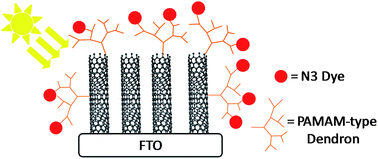Dye functionalisation of PAMAM-type dendrons grown from vertically aligned single-walled carbon nanotube arrays for light harvesting antennae
Abstract
Vertically aligned

* Corresponding authors
a
Centre for Nanoscale Science and Technology, School of Chemical and Physical Sciences, Flinders University, Sturt Road, Bedford Park, Adelaide, SA, Australia
E-mail:
Mark.Bissett@flinders.edu.au
Fax: +61 8 8201 5339
Tel: +61 8 8201 2005
Vertically aligned

 Please wait while we load your content...
Something went wrong. Try again?
Please wait while we load your content...
Something went wrong. Try again?
M. A. Bissett, I. Köper, J. S. Quinton and J. G. Shapter, J. Mater. Chem., 2011, 21, 18597 DOI: 10.1039/C1JM13957F
To request permission to reproduce material from this article, please go to the Copyright Clearance Center request page.
If you are an author contributing to an RSC publication, you do not need to request permission provided correct acknowledgement is given.
If you are the author of this article, you do not need to request permission to reproduce figures and diagrams provided correct acknowledgement is given. If you want to reproduce the whole article in a third-party publication (excluding your thesis/dissertation for which permission is not required) please go to the Copyright Clearance Center request page.
Read more about how to correctly acknowledge RSC content.
 Fetching data from CrossRef.
Fetching data from CrossRef.
This may take some time to load.
Loading related content
